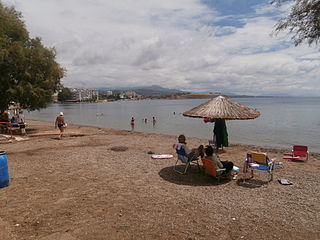 W
WAssiros is a village and a former municipality in the Thessaloniki regional unit, Greece. Since the 2011 local government reform it is part of the municipality Lagkadas, of which it is a municipal unit. The 2011 census recorded 1,975 inhabitants in the village of Assiros, 2,216 inhabitants in the community and 3,861 inhabitants in the municipal unit. The community of Assiros covers an area of 55.369 km2, while the respective municipal unit covers an area of 76.657 km2.
 W
WAzoria is an archaeological site on a double-peaked hill overlooking the Gulf of Mirabello in eastern Crete in the Greek Aegean. "Azoria" is a local toponym, not apparently an ancient place name or epigraphically-attested Greek city.
 W
WEleutherna, also called Apollonia (Greek: Ἀπολλωνία), was an ancient city-state in Crete, Greece, which lies 25 km southeast of Rethymno in Rethymno regional unit. Archaeologists excavated the site, located on a narrow northern spur of Mount Ida, the highest mountain in Crete. The site is about 1 km south of modern town of Eleftherna, about 8 km north east of Moni Arkadiou, in the current municipality of Rethymno. It flourished from the Dark Ages of Greece’s early history until Byzantine times.
 W
WKavousi Kastro is an archaeological site in eastern Crete, Greece, about 1.4 km southeast of the modern village of Kavousi, a historic village in the municipality of Ierapetra in the prefecture of Lasithi.
 W
WKavousi Vronda is an archaeological site in eastern Crete, Greece, located about 1.25 km south of the modern village of Kavousi, a historic village in the municipality of Ierapetra in the prefecture of Lasithi.
 W
WKerameikos also known by its Latinized form Ceramicus, is an area of Athens, Greece, located to the northwest of the Acropolis, which includes an extensive area both within and outside the ancient city walls, on both sides of the Dipylon (Δίπυλον) Gate and by the banks of the Eridanos River. It was the potters' quarter of the city, from which the English word "ceramic" is derived, and was also the site of an important cemetery and numerous funerary sculptures erected along the road out of the city towards Eleusis.
 W
WLefkandi is a coastal village on the island of Euboea, Greece. Archaeological finds attest to a settlement on the promontory locally known as Xeropolis, while several associated cemeteries have been identified nearby. The settlement site is located on a promontory overlooking the Euripos, with small bays forming natural harbours east and west of the site. The cemeteries are located on the hillslopes northwest of the settlement; the plots identified so far are known as the East Cemetery, Skoubris, Palia Perivolia, Toumba, in addition to further smaller groups of burials. The site is located between the island's two main cities in antiquity, Chalkis and Eretria. Excavation here is conducted under the direction of the British School at Athens and is ongoing as of 2007.
 W
WToumba is a district in eastern Thessaloniki, Greece. It is densely built-up and is divided into Ano Toumba and Kato Toumba by a flume, and it is part of 4th Division of Thessaloniki Municipality.